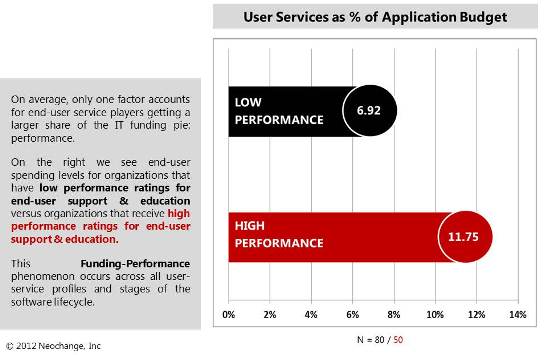Editor’s Note: Oracle UPK teamed with Neochange to produce the 4th annual IT Adoption Insight Report. The report focuses on findings around user service success, as revealed by 300 companies participating in the survey.
The results of our 2012 Adoption Insight survey are in. Our study revealed that effective usage rates of enterprise software are down compared to two years ago. More disturbing is the fact that survey participants reported that end users are experiencing productivity losses of around 17%. This is a big number. It’s like giving everyone Friday off. At 17%, the economic value of user losses outweighs 100% of total IT spend. Ouch.
Many factors contribute to this problem but, simply put, end users are struggling to absorb the glut of IT investments made over the past several years. This IT consumption shortfall may have been excusable a decade ago; but with the industry’s collective deployment experience being so mature, it is fair to ask: “how did this happen?” And further, how could any IT organization possibly declare deployment success when software’s promise is so heavily overshadowed by end-user struggles?
The results of our research show that almost 80% of companies cannot declare victory if the bar is set at the level of user success. As we dug into the details of the 300 surveyed companies, we found that the less successful are characterized by an outdated focus on technology ahead of users – a tech focus versus a user focus, if you will. The gap in success between these two ways of thinking is quite stunning.
Three benefits of focusing on users rather than technology in the software life cycle
A user-focused approach to the software life cycle is superior, and here are three reasons why:
- Lower technology costs. Technology-focused organizations spend ~13% more on IT than their user-focused peers as a percentage of revenues. Spending levels would not be a problem if they delivered better business results. But they don’t.
- Lower user productivity losses. The efficiency with which user’s consume their enterprise applications is affected by many factors including feature complexity, information overload and application documentation. The user productivity loss of tech-focused organizations is 2.3 times greater than user-focused organizations. Tech-focused organizations are leaking almost a quarter of their users’ application usage time.
- Higher business productivity. We compared revenue-per-employee within industry peer groups to get a sense of how well each profile drives business productivity. Again, user-focused organizations outperformed the tech-focused companies, achieving 23% higher revenue-per-employee against their industry peers.
Smart moves of user-focused companies
So what key practices do user-focused organizations do differently from tech-focused organizations? They implement three best practices:
- Invest in user empowerment. One of the stand-out practices of the user-focused organizations is their commitment to investments in self-service, education simulations and Super User Programs – investments that enable user self-sufficiency. This focus contrasts with the traditional investments in a reactive help desk and premium support during upgrades.
- Work adoption well before deployment. There is a direct correlation between starting user adoption efforts in the discovery phase of the software life cycle and adoption rates of technology. Our study found that user-focused companies start their organizational change efforts early and achieve 300% higher returns on their end-user programs than the tech-focused practice of starting with/after deployment.
- Share usage transparency. Organizations getting the best business results from their technology monitoring the usage behaviors of their end users and share this adoption insight with all the service functions (development, education and support) that impact user success. This is critical to avoiding redundant and conflicting agendas that are typical of fragmented service delivery. Organizations that monitor usage also receive higher customer satisfaction scores.
These three power-plays acknowledge a significant reality – that most users live in dynamic, complex business environments and cannot be adequately served by temporary, implementation-centric user programs.
Determining the right user-to-technology spending ratio
All this discussion of investing in users versus technology begs the question of what is the appropriate mix of user-to-technology investments. On average, the 300 companies in our study allocated 8.32% of their application budgets to spending on users. Clearly this is not enough if these investment levels deliver a 17% end-user productivity loss and only 52% effective usage. For most companies when it comes to spending on users, more money is better. But how much is enough?
Should the bar be set at 30% just like the innovation-to-maintenance investment target of application portfolios? That would be a fantastic stimulus package for user adoption but not a practical recommendation in an environment where user-service functions are rarely able to explain their economic contribution.
What we know from the study is that organizations that are considered high performers in the delivery of their user services spend closer to 12%, much higher than the under-performing laggards in the dreaded Drag Zone (low adoption, high user losses). This 50% increase above-average investment level sounds hefty, but the economic upside is quantifiable and compelling.
User spending, the new leading indicator of IT success
As leading indicators of IT success go, the ratio of maintenance-to-innovation spending has been used for as long as I can remember. Logic follows that more spending on innovation is good for business and that the dreaded 80/20 ratio must be overcome to declare CIO success. This logic is true but woefully limited in the context of underperforming software investments and end-user productivity losses. The problem with the maintenance-to-innovation success measure should be obvious. If users are still struggling with the “old stuff,” a whole bunch of innovative “new stuff” isn’t necessarily going to make things better – at least not without more spending on users.
Chris Dowse is co-founder and CEO of Neochange.
Kathleen Goolsby is managing editor at SandHill.com.

